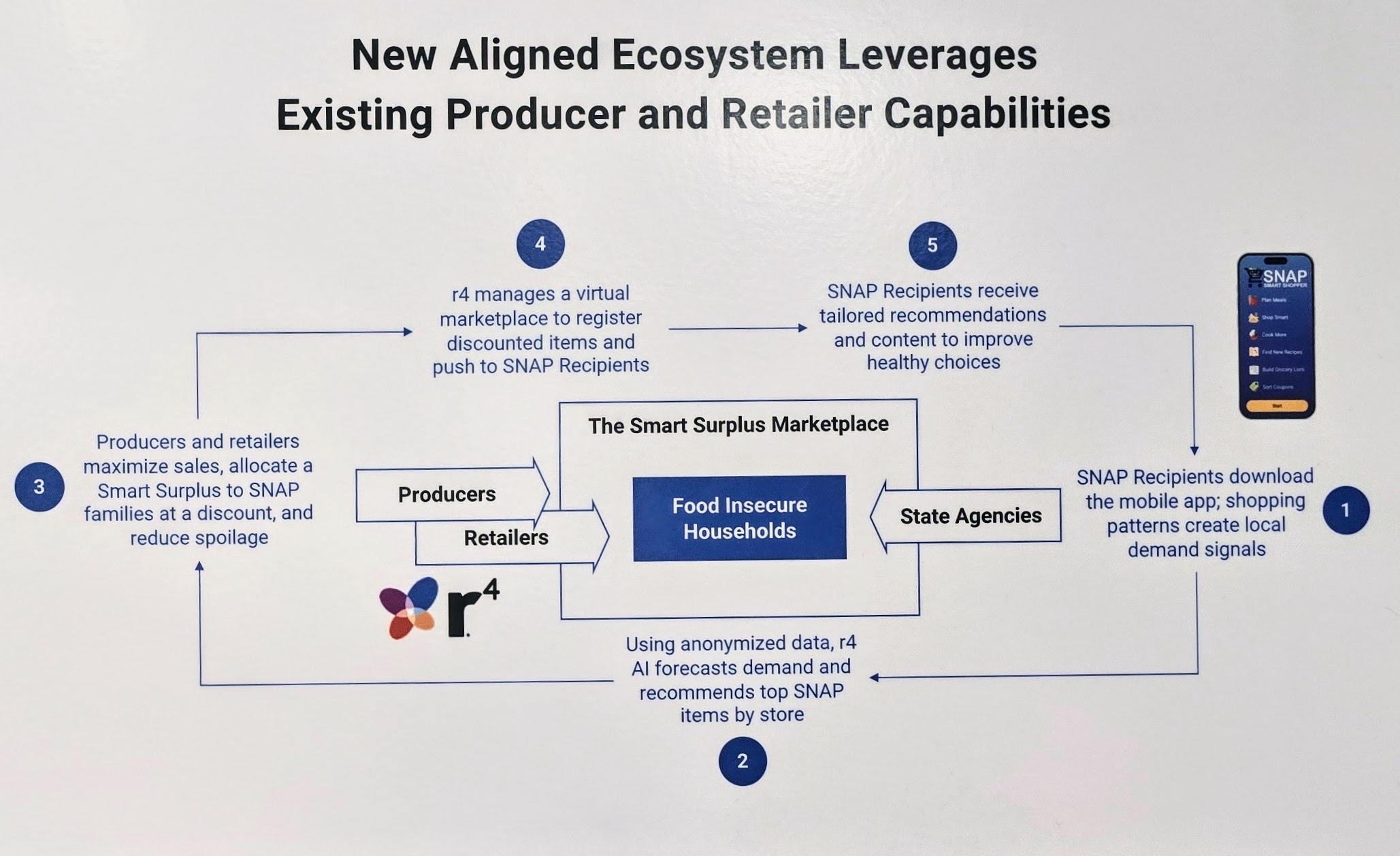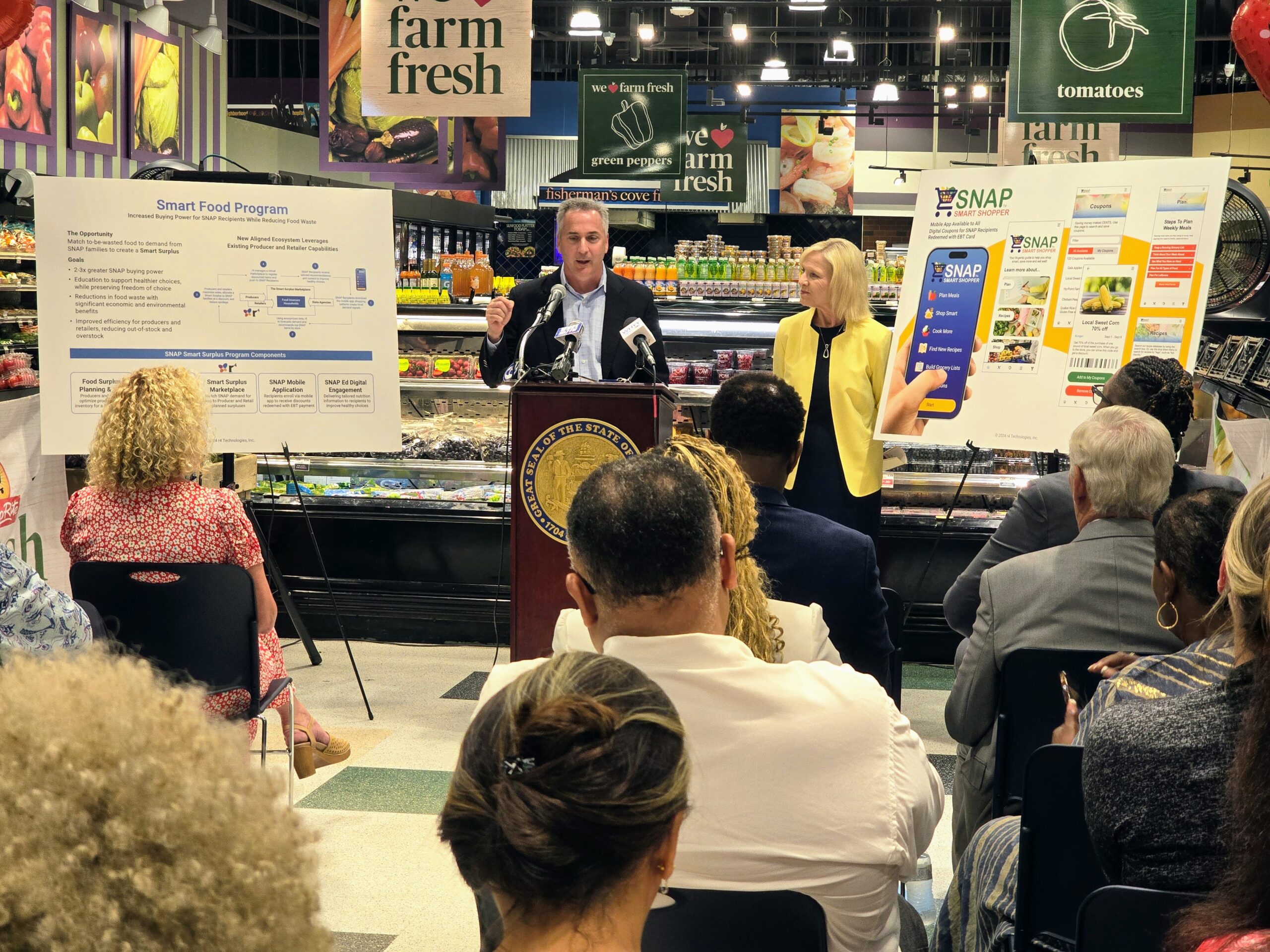When Daniel Walker was a child, he remembers seeing his mother struggling to feed his family of five kids.
Last week, Walker, now Delaware Department of Health and Social Services deputy secretary, shared that story at an event in ShopRite Christina Crossing’s produce department. The event celebrated Delaware’s launch of the nation’s first Smart Food Program for SNAP customers. The program aims to use technology to help today’s struggling families stretch their grocery budgets while reducing food waste.
The program, created through a public-private partnership of state agencies, nonprofits and AI company r4 Technologies, is rooted in the $1.7 billion White House Challenge to End Hunger and Build Healthy Communities. Lt. Governor Bethany Hall-Long leads the initiative, which uses $1.5 million in federal American Rescue Plan Act funding.
At the center of the Smart Food Program is an app, which is expected to be available by the end of the year. It has two main goals: To stretch grocery dollars provided by SNAP, the Supplemental Nutrition Assistance Program, to low-income individuals and families by offering app-based coupons and budgeting assistance, and to substantially reduce grocery food waste, which is at a level of 30% to 40% in the US, by using predictive data analysis.

This is not a program that will push discounted food past its prime on low-income families — in fact, this technology sets out to eliminate selling food past its prime to anyone.
“The big idea is to find the supply signals in the data, and then, on the front end, match the demand forecast to those supply signals,” Paul Breitenbach, founder of Connecticut-based r4 Technologies, told Technical.ly.
Predictive data tells suppliers which stock sells well
As cofounder of Priceline, Breitenbach is no stranger to money-saving platforms.
Breitenbach somewhat downplays the AI aspect of the Smart Food app — when he spoke about the technology at the event, he made a point not to say the word “AI.” But it is AI that makes it possible to predictively and anonymously analyze app data so that a grocery supplier can know how much of certain items will sell in a given time, and where excess perishables like produce will sell long before they go bad.
The way things work without predictive data analysis, stores often receive items that don’t match their buyers’ shopping habits. If there is a bumper crop of corn, for example, all of the stores get lots of corn, instead of sending more corn to stores that regularly sell out of it and less to stores that regularly discard unsold corn. This contributes to the food waste issue, a loss that stores account for in their budgets.
With predictive data, grocery stores can be assured that more of their stock will sell before the sell-by date with few or no discards. So, for example, if a package of chicken sells for $8 for non-SNAP customers, with less food waste impacting the bottom line, they can offer that same package of chicken for $4 to SNAP recipients the minute it hits the shelves.
The stores will get less money from SNAP sales, Breitenbach said, but if that percentage of food would ordinarily be thrown away, any amount of money they sell it for is now profit.
“The big innovation here is starting with the demand signal and then using that to overlay to the supply,” Breitenbach said.
SNAP customers will get coupons and advice on ways to use what they buy
For the SNAP consumer, the app will customize itself with use, making it as easy as possible for users to find deals on products they use regularly, and how to get more out of products.
Breitenbach uses inexpensive dark-meat chicken as an example.
“I grew up not eating dark meat chicken,” he said. “So while I might like chicken, I might not know what to do with dark meat.”
The app will help with that by pairing recipes with SNAP coupons so that if you spend $10 on chicken, you can see how buying a larger package of thighs might equal several meals — say, by turning it into multiple servings of pulled chicken for sandwiches, tacos or rice, versus one meal made with more expensive chicken breast.
Similarly, the app includes budget planning to help SNAP funds last a full month.
More stores across the country will adopt the app
Participation in the program is voluntary for stores that accept SNAP, but there are already retailers asking if they can link their store savings card to the app. That feature may come in the future.
Kenny Family ShopRites of Delaware has been on board with the program since the beginning, with its executive vice president Melissa Kenny taking an active role in clearing the way policy-wise.
It took more than a year for leaders in Delaware to get a waiver from the USDA that allows the variable pricing in the Smart Food Program, which has cleared the way for other states to apply.
“That was a really, really big deal,” Breitenbach said.
The second state slated to adopt the program is Hawaii, with Oklahoma and Florida showing interest.
“They’ve all raised their hands saying they want to do it,” Breitenbach said, “but they know that by law, they had to have this waiver.”







